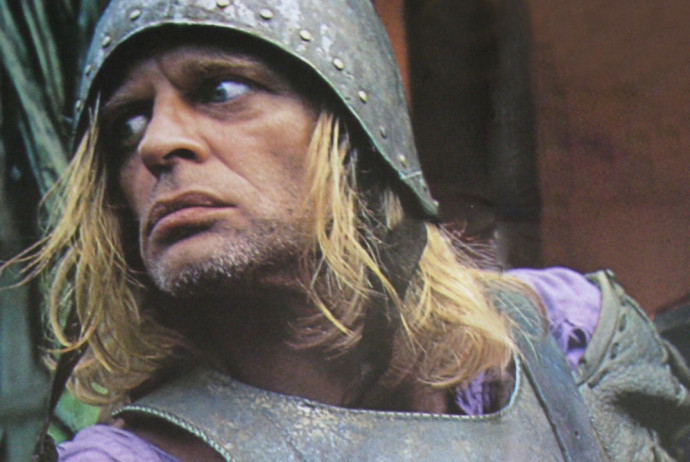Dir: Werner Herzog
Star: Klaus Kinski, Helena Rojo, Ruy Guerra, Del Negro
Werner Herzog almost didn’t get out of this one alive – and that wasn’t even anything to do with Kinski. While location scouting, a change in itinerary meant he was taken off the passenger list of a plane at the last minute: it crashed in the jungle, killing almost all those on board [the sole survivor was the subject of his later documentary, Wings of Hope]. He didn’t take the hint, and persevered with what must have been an absolute nightmare of a shoot. The opening shots, of the Spanish conquistadors struggling their way down a mountain and through the jungle give some hint of what it must have been like, even with a small crew, dealing with a jungle where water levels could change by 15 feet overnight, flooding intended locations. Even for the early seventies, a budget of less than $400,000 was still remarkable.
This was the first Herzog/Kinski collaboration – they’d known each other since Klaus had been another tenant in the boarding house where Werner lived as a teenager, and the actor had made a lasting impression. Herzog said of the Aguirre role, “The moment I finished [the screenplay], I knew it was only Kinski,” and from virtually the first shot, of Kinski glowering insanely from under the brow of his armour, show precisely why the choice was an impeccable one. Impeccable, if not easy: in the DVD commentary, Herzog tells of Kinski firing his rifle into the extras’ hut, after their late-night noise disturbed him. There was another incident, where Kiinski threatened to leave the production, only staying after Herzog threatened to shoot them both, though the urban legend about the actor being directed at gunpoint seems untrue.
The film was originally shot in English, as the only common language of the cast and crew. However, that soundtrack proved unusable, and so was replaced by a German-language one in post-production. The voice of Aguirre is not Kinski: he demanded too much money for the additional work, and Herzog went with another actor. I also note the more than slight resemblance between Cecilia Lopez, the actress playing Aguirre’s daughter, and Klaus’s daughter, Nastassja, who would have been ten or 11 at the time this was made. The incestuous undertones between the two are pretty clear, and also reflect some of the claims – for which he was sued – about his relationship with Nastassja.
Herzog did want a more restrained portrayal of Aguirre than Kinski, and to get what he wanted, would provoke the actor into a rage, wait for it to blow itself out, and then shoot the scenes, with his lead now in the quiet, calm place desired. This reaches its apex in the single shot which sums up, not only Aguirre’s insanity, but perhaps the nature of the Herzog/Kinski collaboration. Near the end, the raft is inhabited mostly by corpses, Aguirre and hundreds of monkeys. The leader grabs a monkey as he staggers around hie “empire”, now reduced to ruins, and proclaims himself the wrath of God, before tossing the monkey to one side with a gesture that is the most beautiful embodiment of insanity you will ever see. Note the monkey shitting itself at 0:23. Can’t blame it: I’d do the same if Kinski had me by the rib-cage.
It’s interesting to note how little Aguirre is present at the center in the early stages. He’s there, on the fringes, simply waiting his chance, as the advance party of the expedition, under Don Pedro de Ursúa (Guerra), struggles down the river, disintegrating with an irresistible relentlessness. When the moment is finally right, he strikes, taking control of the group and driving it onward. From that point on, everyone is doomed, and it appears that, with the exception of Aguirre, everyone knows it and are simply playing out the inevitable. It’s Shakespearean tragedy, with a man destroyed by his own weaknesses – if Hamlet or Macbeth had been a total loony at the start of the play.
As things degenerate, the only consistent point in the landscape is Aguirre, whose insanity gradually become the norm rather than the exception: “Little mother, two by two, wafts the wind in my hair,” muses one soldier as he hangs Don Pedro. Shortly thereafter, Pedro’s wife wanders off into the jungle, wearing a gown more befitting a royal ball. The survivors see a ship, stuck in the top of a tree, but deny its existence as a mirage. They may or may not be right there, but they are certainly wrong with respect to the undeniably real arrows which strike them out of the jungle.
It’s deliberately paced, things decaying at the speed of the jungle reclaiming an abandoned outpost – there’s no hurry, because it’s not going anywhere. There’s not even any need to dot every i: a rescue party sent to help a raft stuck on the far side of the river simply vanishes into the jungle, their fate undocumented but still absolutely certain. Aguirre, as portrayed by Kinski, is similar: he’s not “evil” in any real sense, and condemning him for his behaviour has about as much point as telling the jungle off. They are both forces of nature, and will do exactly what they want. You’d better not get in the way.
